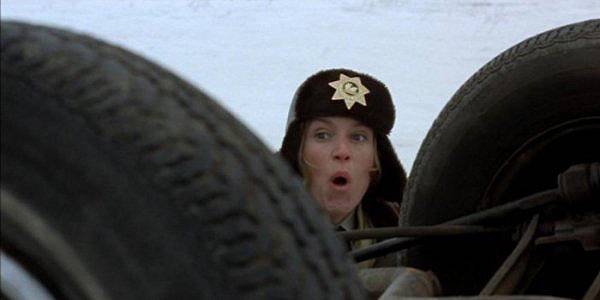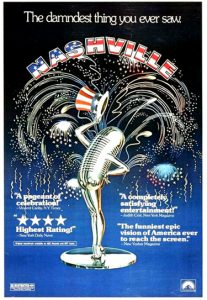Review By Dan Geddes
| Directed by Joel Coen
Writing credits |
| Cast | ||
| Frances McDormand | …. | Marge Gunderson |
| William H. Macy | …. | Jerry Lundegaard |
| Steve Buscemi | …. | Carl Showalter |
| Harve Presnell | …. | Wade Gustafson |
| Peter Stormare | …. | Gaear Grimsrud |
| Kristin Rudrüd | …. | Jean Lundegaard |
| Tony Denman | …. | Scotty Lundegaard |
| Gary Houston | …. | Irate Customer |
| Sally Wingert | …. | Irate Customer’s Wife |
| Kurt Schweickhardt | …. | Car Salesman |
| Larissa Kokernot | …. | Hooker #1 |
| Melissa Peterman | …. | Hooker #2 |
| Steve Reevis | …. | Shep Proudfoot |
| Warren Keith | …. | Reilly Diefenbach |
| Steve Edelman | …. | Morning Show Host |
SUMMARY
Fargo dramatizes how one small crime can snowball into a series of tragedies. Criminals are often not the smartest human beings, and the law of unintended consequences rules our world.
But it seems so simple. Jerry Lundegaard (Macy) is a Minnesota car salesman who really needs a big score. He owes his job to his wealthy father-in-law, Wade (Presnell), who bullies him and doesn’t trust him to partner with him in business. Jerry has already embezzled money from the car dealership, and needs to pay it back pronto. So he decides to hire some men to kidnap his wife, Jean (Rudrüd), so he can keep most of the ransom money himself when his father-in-law pays it out. That is the plan.
Nothing goes as planned. He hires two kidnappers Carl (Buscemi) and Gaear (Stormare), who are inexperienced and incompetent. Jean puts up quite a fight when they arrive to kidnap her. Then they drive around until a state highway patrolman pulls them over for their expired dealer tags. When the trooper finally notices Jean tied up in the back seat, Gaear shoots him in the face. Then a car slows down to see what happened, and witnesses the shot policeman, and Gaear chases them down and kills them.
At this point, after the three grisly murders, the local sheriff Marge Gunderson (McDormand) takes over the movie. She quickly analyzes the crime scene, and infers a lot of information about the killings. The killers left behind one spectacular clue: the state trooper’s book, in which he had written down their color and model—tan Sierra—and the fact of their dealer plates!
Within a few days Sheriff Marge is in Lundegaard’s office, and asks whether his dealership had had a tan Sierra stolen recently. She immediately detects Lundegaard’s evasiveness and obvious lies. Marge quickly unravels the mystery, walking around with the gentle steps of a pregnant woman. She is pleasant to all people, forgiving of their imperfections, and shines with vitality and intelligence.
Sheriff Marge is clearly the best thing in the movie. She is self-possessed, and generally happy, despite having seen the worst of human nature. She’s married to Norm, a normal guy who cooks breakfast, and fishes, and paints birds (his work becomes featured on the U.S. $.03 cent stamp).
Marge and Lundegaard are polar opposites. Their two scenes together represent hinge points in the movie. She is moral strength, and courage, and she is satisfied with her normal life. He is weak, and afraid, and envious of the wealth and accomplishments of others. He illustrates how little crimes, like lying to sell extras on his cars, lead to bigger ones, like kidnapping his wife to steal the ransom money from her father. His incompetence is such that seven people will die, and he himself will go to jail. The movie’s opening—Lundegaard towing the tan Sierra from his own lot across the state line to the kidnappers—conveys the tacky nature of the crime. Kidnapping someone for a new car and $20,000; these are the prizes won on American TV game shows (“a new car!”).
Analysis
Fargo has a strong critical reputation. It is undeniably well scripted, directed, and well cast. You sense that the Coen brothers accomplished what they had set out to do, but what is that exactly? To show how little crimes lead to big crimes? To make fun of the stupidity of people? Whatever the Coen brothers’ artistic objectives, Fargo leaves me feeling unclean and depressed.
For one, Fargo is a violent movie. The killings take place in middle America, rather than the usual New York or LA crime zones, and so seem more shocking. The Coens’ approach here betrays the influence of Scorcese and Tarantino, including their blending of violence with pop culture. However, Fargo’s killers (unlike those of Goodfellas or Pulp Fiction) are misfits. And they are not cool. Their dialogue is neither funny nor sparkles with references to American pop culture. Yet these are key ingredients of this genre: the hip kidnapping film. The Coens’ own Raising Arizona and The Big Lebowski are other examples, but they are both funnier and less violent (and have much better soundtracks).
Fargo is not really very funny. Some viewers find the Upper Midwest accents pretty funny. Others laugh at just how stupid everyone is. Of course Sheriff Marge shines like an angel, but she doesn’t deliver zingers. She can tear open a petty man like Lundegaard with a few questions, but he is hardly worthy of her powers.
Watching Fargo is a bloody business. I count seven murders, and nearly all of them happen right in our face. If Pulp Fiction showed us many murders in broad daylight, Fargo shows us blood against a backdrop of against white snow. (Think “Chipper Scene,” but also the killings of the state trooper, witnesses, and Wade.) Fargo‘s murders pack a Pulp Fiction-like punch, but with a real human being in this movie—Sheriff Marge—we cannot discount the killings as readily as in Pulp Fiction, where we are expected to treat death as if it were a cartoon or video game.
Fargo has something of a moral compass in Marge. She understands criminals, and human nature in general. After finally capturing Gaear, she is incredulous: “All those dead people, and for what? For a little bit of money. And it’s such a beautiful day.” We share the tragedy of the moment with her. We feel something. And yet the bloodbath does not seem to have changed her, or even affected her, and so we are not so affected. And the rest of the characters prove disposable and not memorable.
The Coen brothers fail to glorify their villains. Lundegaard and Carl and Gaear are seen as without redeeming values. Even though Lundegaard is a weak criminal, we sometimes see the movie through his eyes, and so share his sense of dread as things spiral out of control. The laconic kidnapper Gaear is not fun to watch. He’s on screen a lot, he doesn’t say much, and he only sports a few character touches (chain-smoking, wanting to stop for waffles). Yet by the end of the movie, he has killed five people, and for no reason. (In contrast, imagine the humor, cool, and pop-culture credibility that John Goodman—perhaps playing a character like Walter in The Big Lebowski—could bring to this role.) Buscemi’s Carl is certainly the smarter of the two, but still nasty, cocky, and still stupid. Eyewitnesses can only describe him as “funny looking,” but in no particular way.
The Buscemi character is credible, because we know that the weak are often afraid and wish to tyrannize others. Is that the great lesson of Fargo?
Why do people like this movie so much, its craftsmanship notwithstanding?
See also:
The Big Lebowski, Burn After Reading and Inside Llewyn Davis






Be First to Comment